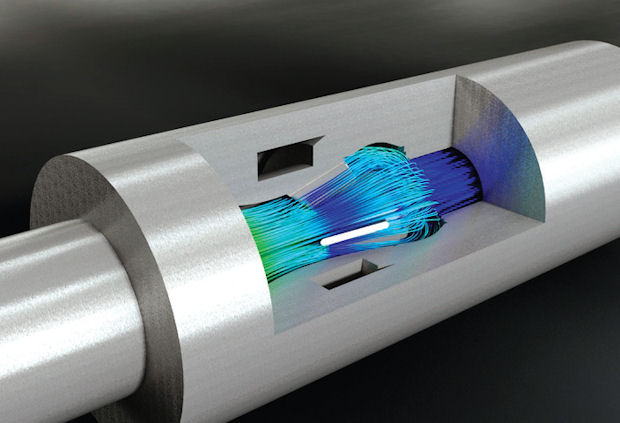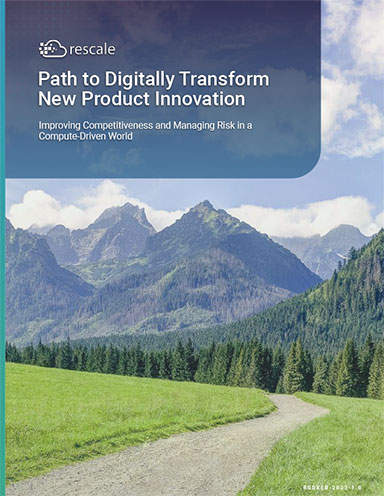Testing Simulation with Cloud Computing

Sending solutions to the cloud could reduce the time to collect a complete data set by an order of magnitude.
Latest News
November 1, 2014
By Mark A. Lobo, P.E.; Jon den Hartog, P.E.; Derrek Cooper and Wolfgang Gentzsch
Engineers and scientists can use various types of simulation during design and development to reduce costs, reduce project risk, accelerate time to market, and deliver higher-quality products. Using specialized computing hardware for this simulation work can dramatically improve productivity by removing bottlenecks posed by some workstations. According to a study of the U.S. Council of Competitiveness, however, less than 10% of manufacturers are using technical servers for simulations. The vast majority of companies perform virtual prototyping just on their workstations, but 57% report they have application problems that they can’t solve because their desktops are too slow or because the geometry or physics are too complex.
There is another option today to get additional technical computing power: the cloud. Computing resources in the cloud allow engineers to continue using their workstations for daily design and development, as well as common office tasks, and to submit larger, more complex, more time-consuming jobs to be solved elsewhere. Benefits of cloud computing are on-demand access to “infinite” resources, pay per use, reduced capital expenditure, higher-quality results, lower risks and product failure rate, and greater business agility by dynamically scaling computing resources up and down as needed.
The UberCloud Experiment started in July 2012, exploring hands-on cloud computing for engineers and scientists and to learn about cloud hurdles and how to remove them. Since then the UberCloud Experiment has attracted 2,000 organizations from 72 countries, and 155 teams in computational fluid dynamics (CFD), finite element analysis (FEA), biology and other domains have been built, and many case studies published in the 2013 Compendium and the 2014 Compendium of UberCloud Experiment case studies, available here. The UberCloud Experiment provides a platform for scientists and engineers to explore, learn and understand the end-to-end process of accessing and using cloud resources, and to identify and resolve the roadblocks. End-users, software providers, resource providers and computing experts collaborate in teams to jointly solve the end-user’s application in the cloud.
Taking Computing on the Cloud from Concept to Reality
Flow control valve specifications include performance ratings for a valve to be properly applied in fluid management systems. Control systems sort out input parameters, disturbances and specifications of each piping system component to react and produce a desired output. System response is chiefly a function of the accuracy of control valves that respond to signals from the control system. Valve performance ratings provide information to the system designer that can be used to optimize control system response and predictable restriction vs. the input signal range, the inherent characteristic, which requires hundreds of simulations to verify and optimize.
One experiment by Mark A. Lobo, P.E., Principal, Lobo Engineering PLC focused on a control valve where the effects of a complex body cavity and trim design were critical to overall performance. The flow path for the valve is shown in Fig. 1. The restriction components, or “trim,” reduce the annular area as the cavity profile on the right moves to the left. The location of highest velocity is indicated in red. The design objective was to direct the fluid away from the containment surfaces that otherwise would be damaged by cavitation.In Lobo Engineering’s UberCloud experiment, the cloud was used to complete several sweeps of simulations to characterize the performance of this valve in various operating conditions. Rather than solving these simulations sequentially, as would be done with a typical license and hardware setup, most of the simulations were solved in parallel in the cloud to maximize throughput and allow studies of various conditions and geometries to be studied relatively quickly.
The Virtual Valve Test
Autodesk Simulation CFD, the simulation tool used in the project, employs solution methods based on well-understood fluid dynamics principles, and provides the option to solve locally or in the cloud. The iterative approach to solving the embedded fluid flow equations is presented graphically to provide an appraisal of the program’s progress converging toward a solution. Adjustments can be made to settings such as mesh controls, solution methods, advection model and more. After acceptable results are realized locally with confidence in the program settings, multiple scenarios can be sent to the cloud to free up local resources and reduce analysis time.
 Sending solutions to the cloud could reduce the time to collect a complete data set by an order of magnitude.
Sending solutions to the cloud could reduce the time to collect a complete data set by an order of magnitude.The valve test simulation boundary conditions are set in the same manner as a physical test setup. The upstream and downstream pressures are applied, and Simulation CFD solves for the flow rate. During the course of this project, more than 200 simulation scenarios were solved in the cloud. The cloud solves were performed on a pool of Amazon EC2 m2.4x large instances, each with eight physical cores and 64.8 GB RAM. The local solves were performed on a HP Z800 Dual 2.4GHz Quad Core E5620 Workstation, 24GB RAM, with AMD’s ATI FirePro V5800 1GB Graphics Adapter. Flow data was collected for six control positions of a representative control valve, and 10 combinations of pressure drop for each position, or travel step, from 20% open to 100% open. The data was analyzed in the same manner as if it was generated through physical testing to produce the inherent characteristic for fully developed turbulent flow, and the effect of choked flow on performance.
The premise of this project was not only to explore virtual valve testing, but to evaluate the practical and efficient use of CFD by the non-specialist design engineer. As a benchmark, the end user had no prior experience with the software when the project initiated, no formal training in the software, and depended on the included tutorials, help utility and thorough documentation to produce good results and good data. In the end, the time and effort required to run virtual valve tests compared well to equivalent physical tests. The investment to equip a valve manufacturer’s test lab would be one to two orders of magnitude greater than the resource investment required to have the capability to run a “test in the cloud” of a control valve.
Benefits of the Cloud
Because of the computational requirements for each simulation, engineers often cannot set up and run the spectrum of simulations they would like within the time available. Limited hardware and software licenses often act as the bottleneck in a simulation project—leaving engineers to virtually test only a limited number of cases.
It is certainly possible to get around this problem by making a significant investment in computing hardware and software licenses in the form of HPC clusters and simulation solvers. This approach is appropriate for specialized simulation analysts at large organizations, which can typically maintain high enough utilization on the hardware and software to get a good return. The vast majority of engineers, however, have fluctuating demands for simulation that depend upon their project work. Most engineers involved in design work have intermittent simulation needs, but when they do require it, they demand hardware and licenses as any full-time analyst would.
Cloud computing enables the design engineer to access a large amount of computing power in a cost-effective way. Rather than owning the hardware and software licenses, engineers can pay for what they need when they need it, rather than making a substantial upfront investment.
The cloud reduced solution time by at least a factor of three, with the local workstation dedicated to the CFD analysis. During the project, local solution times increased by another factor of three when the local workstation was in use for intensive modeling work while a simulation was running. If a workstation is required to be actively used for other work during simulations, sending solutions to the cloud reduces the time to collect one data set for 10 scenarios by an order of magnitude.
Accounting for runtimes and data download upon completion of each of the runs, it would be possible to solve the 200 simulations for this project within a day. For an engineer with one simulation license on a single workstation, this would have required 800 hours—approximately 30 days—to complete if the simulations were running nonstop, one after another. Table 1 compares the approximate time and investment that would be required for various solving approaches.
Engineers who are interested in participating in a similar experiment to perform their simulations on an external technical cloud computing resource are invited to register at TheUberCloud.com/hpc-experiment.
Mark A. Lobo is principal, Lobo Engineering PLC. Jon den Hartog is senior product line manager, Autodesk. Derrek Cooper is director of Autodesk’s digital simulation product line. Wolfgang Gentzsch is an industry executive consultant for high performance, technical, and cloud computing. Contact them via theubercloud.com or send e-mail about this article to DE-Editorsmailto:[email protected].
More Info
Subscribe to our FREE magazine, FREE email newsletters or both!
Latest News







